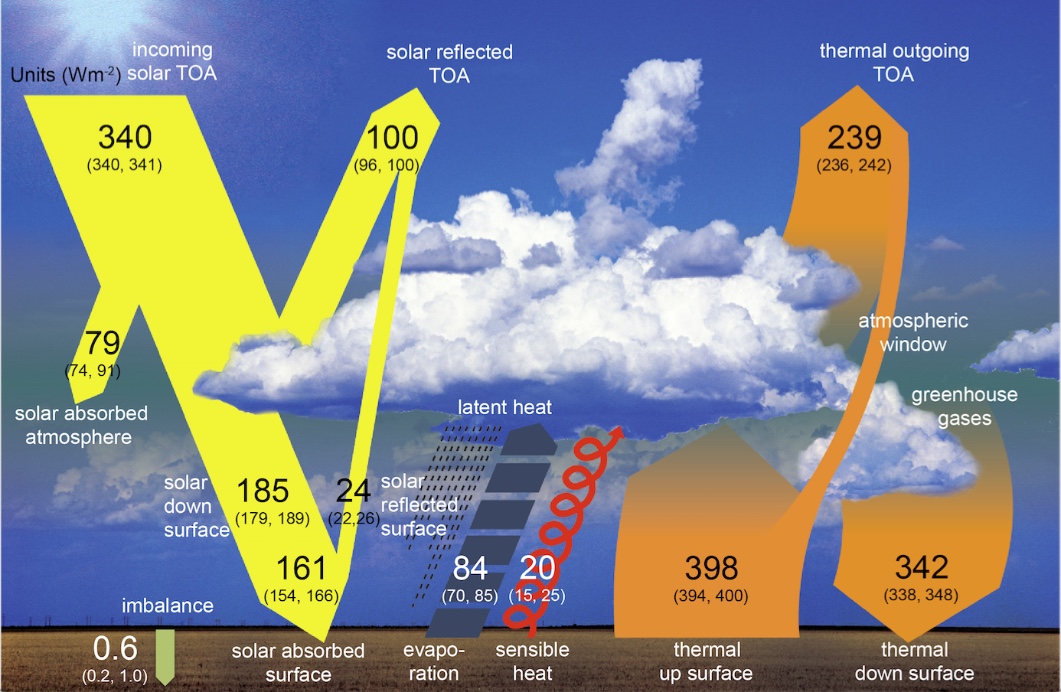The technical term for the value that differs between contrails and stratospheric sulfate aerosols (SSA) is "net radiative forcing".
"
Radiative forcing" is simply the difference between incoming radiation from the sun, and outgoing radiation from the earth. Incoming radiation is the various forms of radiation from the sun (infrared heat, visible light, ultraviolet light, and others) and is basically constant (with solar variability being a separate factor). Outgoing radiation is more complex, as there's the reflected radiation, from the clouds, the atmosphere, and the earth's surface, then there's the emitted radiation, which is mostly infrared heat, and is the dominant factor at night - i.e. the side of the earth that currently gets no sun is just radiating out heat into space.
Clouds (including contrails) and other things like dust and aerosols in the atmosphere, and even the molecules of the gases in the atmospheres, all have different effects on the different types of incoming and outgoing radiation. They are more transparent to some wavelengths, and less so to others. This is important as the radiation from the sun changes after it's absorbed by the earth and re-radiated. The incoming radiation has lots of different types, some types are partially reflected by different things in different amounts. The outgoing radiation has fewer types (it's basically heat, i.e. infrared radiation), but it's also affected differently by different things.
The "net" part of this means the sum of all the effects for a particular factor. Any one factor can have a complex effect (and often poorly understood, and just estimated). Something like Carbon Dioxide will have an estimated "net radiative forcing" of a certain number of watts per square meter (a watt is a unit of energy) for each increase in concentration in the atmosphere. But it's complicated as there's different effects on different types of radiation.

Getting down the difference between SSAs and contrails. Contrails are essentially cirrus clouds, made of tiny ice crystals. They are more transparent to incoming radiation from the sun, and less transparent to outgoing radiation from the earth, so they tend to trap more heat than they reflect. They have a positive net radiative forcing.
SSAs, when high enough in the sky, will block more incoming radiation than they trap, because of the different particle sizes, and where they are in the sky (the stratosphere is above where contrails form). So they have a negative net radiative forcing.
But again it's complicated, and the precise figures are difficult to discern. There can also be compounding factors, and feedback effects. SSA's can possibly create more clouds as they fall out of the atmosphere (over many years). They also alter the chemistry of the atmosphere, damaging the ozone layer. Contrails might lead to an increase in overall invisible cirrus haze of a type that can block some light.
We know that SSA's kind of work because of studying what happens after large volcanic eruptions pump a lot of them into the atmosphere. So that seems like a good contender for geoengineering, as it would mimic a natural process, and is naturally reversible.
We've also observed changes in the atmosphere and radiative forcing that seem to be correlated with contrails. It's possible we could do a type of geoengineering by changing where and when planes fly to change the net effect of contrails and contrail induced cirrus haze.
But the climate is complex and chaotic, and we've only got the one, and it's slow to react, so you can't easily experiment with it. So there's a lot of uncertainty, which is one reason people are generally very reluctant to try geoengineering and prefer instead to focus on reducing carbon emissions.

